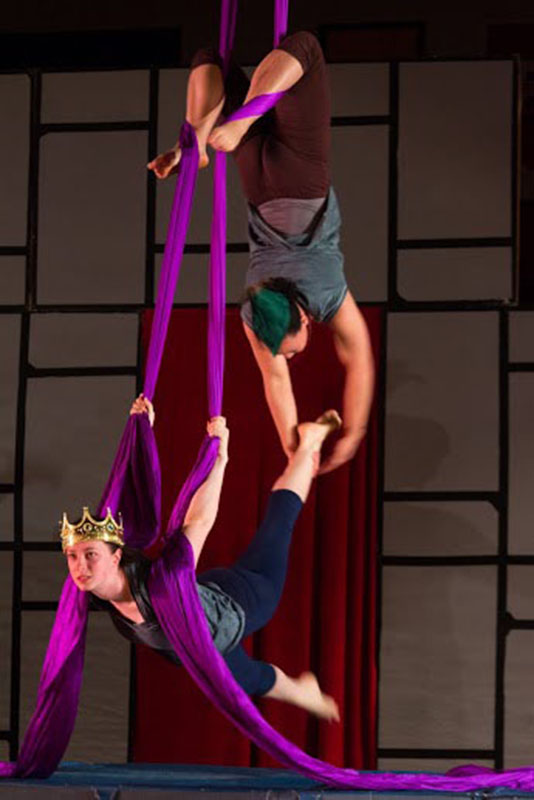OCircus!’s ‘King Bidgood’ Delights All Ages
Seniors Karellyn Holston (top) and Sam Karpinski perform an aerial silks act at OCircus!’s show ‘King Bidgood’s in the Bathtub,’ which took place at Philips gym last Friday and Saturday nights. The show attracted a large crowd of students and Oberlin families.
April 18, 2014
Whenever the page in the OCircus! production of King Bidgood’s in the Bathtub yelled, “Help! King Bidgood’s in the bathtub and he won’t get out!” audience members in Philips gym last weekend knew they were in for another great, highly entertaining act. The plot of King Bidgood is simple: a childish king has gotten in the bathtub and refuses to get out, prompting the royal page to call for help. Each and every time, a different group heeds the request and attempts to entertain the king out of his extended bath.
While the show was definitely designed to be accessible to the many children in the audience, the lead actors played a huge part in keeping the show interesting and entertaining even for the 12-and-up crowd. College senior Joshua Selesnick shone as King Bidgood. Even when he was not the center of the action, he maintained his cheery attitude, reacting with childlike mirth to every act. Rosycheeked and smiling, he successfully captured the king’s toddler-esque tenacity. The show’s narrator, played by College sophomore Austen Read-McFarland, also contributed to its good-humored nature. In a high wicked-witch-ofthe-west style voice, Read-McFarland delivered almost every line of the show with a charisma that further energized the enthusiastic cast. College junior Sarah Cayer’s turn as the page entrusted with coaxing the king out of his bath was impressive for its perfect mix of guile, frustration and obsequiousness in her movements and reactions. College first-year Roux Nemaei’s role as the Queen, though small, showcased her chemistry with Selesnick and humorous sarcastic faces helped to enhance King Bidgood’s childish believability.
The main attraction of OCircus!’s presentation was, as always, the real circus-style acts that, in this case, came out of the woodwork to mobilize King Bidgood. A jump rope routine directed by Obie Jump organizer Jenny Mentzer was the first diversion, helping to situate the audience in the show’s childish, fairytale world. Furthering the routine’s charm, it was performed by a passel of adorable, surprisingly talented young girls, each of whom wielded her own jump rope in addition to participating in group tricks like double-dutch and one especially memorable triangular formation. While a few girls struggled with the most difficult tricks, their overall enthusiasm made these few mistakes endearing rather than distracting.
Though the children didn’t return until a brief cameo at the end of the show, the production’s good humor didn’t suffer in their absence. The aerial silks and hoop and the pyramid acrobatics acts both artfully integrated their elegant choreography into the childish storyline. The two aerialists, College seniors Karellyn Holston and Sam Karpinski, exhibited their talents in harmony with the act’s spunky, uplifting music, which prompted them to charmingly playact at the appropriate swells. The aerial act, and the pyramid acro act that followed, both succeeded in fitting their routines into the larger framework of the show — the aerialists were mischievous thieves causing disruption in the castle, while the pyramid acrobats entertained the king as jesters.
The other primarily acrobatic act was incorporated into the show’s plot with similar ease, although its haunting choreography lent a slightly darker tone. The acrobats acted as courtesans at a dance, and though the act did have moments of good humor, it was more serious and elegant than the others. The courtesans’ ball was lovely and stood out pleasingly in the seemingly nonsensical world of King Bidgood.
The acts that best embodied King Bidgood’s essence, though, were parkour and tumbling. The conceit of the parkour act — a jousting match interrupted by a ninja with a double-ended red lightsaber —was just as ridiculous as King Bidgood’s refusal to get out of the tub. The charisma of every one of the performers, from the championship-winning jouster to the two “horses” was remarkable, no matter how small the role. The tumbling routine was likewise delightful. Performers were dressed in swimsuits and the act was pool-themed (to the bathtub-bound king’s delight). Audience participation heightened the act’s tension — performers leaped onto a springboard and were catapulted over the head of the visibly nervous audience member standing in between the board and the mat. Even though she looked a little scared as the performers leaped over her, the participant still could not stop smiling and laughing, mirroring the reaction of the rest of the appreciative audience.
Suffice it to say that it was very easy to feel like a child again during the performance of King Bidgood. Between musician Delwin Campbell’s sweet, simple score and the ecstatic energy of the performers, one felt immersed in a pool (or, more aptly, a bathtub) of childlike wonder. In fact, it is because of the performance’s simplicity, rather than in spite of it, that King Bidgood was such a success. It was a shame that the page had to pull the plug.

















